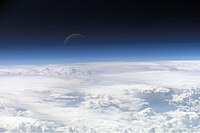Terrestrial atmospheric lens

Imagine you are playing with a magnifying glass on a hot sunny day. When you hold the magnifying glass between the sun and a piece of paper, the sun's rays pass through the glass and focus on the paper, making it burn.
The atmosphere around the Earth can act like a magnifying glass too. As light from stars travel towards the Earth, it enters the atmosphere and gets bent or deflected, just like when the magnifying glass focuses sunlight. Because of this, sometimes the stars appear to be in a slightly different position than they actually are.
Now, let's talk about the Terrestrial Atmospheric Lens. It's a natural phenomenon that occurs in the Earth's atmosphere when certain layers of air have different temperatures and densities. When starlight passes through these layers, it gets bent and channeled towards the observer on Earth. This can actually enhance the brightness and visibility of stars, making them look bigger and clearer than they would normally appear.
So, the Terrestrial Atmospheric Lens is kind of like a giant magnifying glass that the Earth's atmosphere creates, which helps us see stars more clearly.
The atmosphere around the Earth can act like a magnifying glass too. As light from stars travel towards the Earth, it enters the atmosphere and gets bent or deflected, just like when the magnifying glass focuses sunlight. Because of this, sometimes the stars appear to be in a slightly different position than they actually are.
Now, let's talk about the Terrestrial Atmospheric Lens. It's a natural phenomenon that occurs in the Earth's atmosphere when certain layers of air have different temperatures and densities. When starlight passes through these layers, it gets bent and channeled towards the observer on Earth. This can actually enhance the brightness and visibility of stars, making them look bigger and clearer than they would normally appear.
So, the Terrestrial Atmospheric Lens is kind of like a giant magnifying glass that the Earth's atmosphere creates, which helps us see stars more clearly.
Related topics others have asked about:
